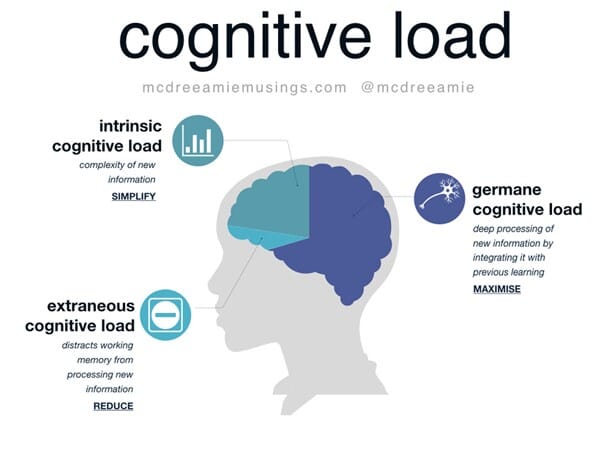1. Manage ‘intrinsic load’ (the complexity of the new material or task itself)
Consider how much new information is being shared at once and the inherent complexity of it. Break it down into manageable chunks (3 is optimal) and sequence these carefully. Provide clear real-world examples for new concepts, show how smaller ‘chunks’ contribute to the bigger picture.
Often complexity cannot be avoided but remember: when someone has a high intrinsic load, their cognitive resources are fully occupied and there simply isn’t room for much else. Activities around complex new information should therefore be straightforward until you can be confident it has been fully understood, otherwise overload will occur.
2. Reduce ‘extrinsic and extraneous load’ (unhelpful additional information or delivery style that distracts from the main content or task)
When content is complex, design activities carefully, asking: does this directly address our purpose? Is there any external ‘noise’ or distraction here? When facilitating, deliver instructions particularly clearly and concisely. Minimise digressions, limit your stimuli and save other information such as housekeeping reminders for a time when content is less demanding.
Carefully devise materials to ensure they work hard to support the session, and do not distract from it. Prioritise clarity and avoid the ‘split attention effect’ when imparting key complex information by thinking carefully about how you present data, ensuring slides and talk do not compete, and allowing resources such as videos to speak for themselves without interruption or additional layers of information.
3. Promote ‘germane load’ (useful ‘load’ - the thinking and learning process)
Set clear objectives and goals for the session and communicate them clearly. Encourage participants to retrieve prior knowledge of a challenging topic before introducing new information (any connections they can make with existing structures and experiences will prove valuable in understanding the new information). Provide useful ‘scaffolds’ and visual aids such as diagrams and flowcharts to help with the processing and storing of complex information, and written prompts to support tasks where needed.
When designing activities around the new information, encourage collaborative activities such as voting, ranking, mapping and co-planning to aid understanding. Summarise and synthesise information as you go. Fit your content into the ‘bigger picture’ of the company’s overall aims and functions. Emphasise the relevance of the information shared: remind participants of how this will impact them and their stakeholders, and allocate individual reflection time. Lastly, return to the information frequently in the future: research supports frequently ‘retrieving’ information will help cement understanding.




